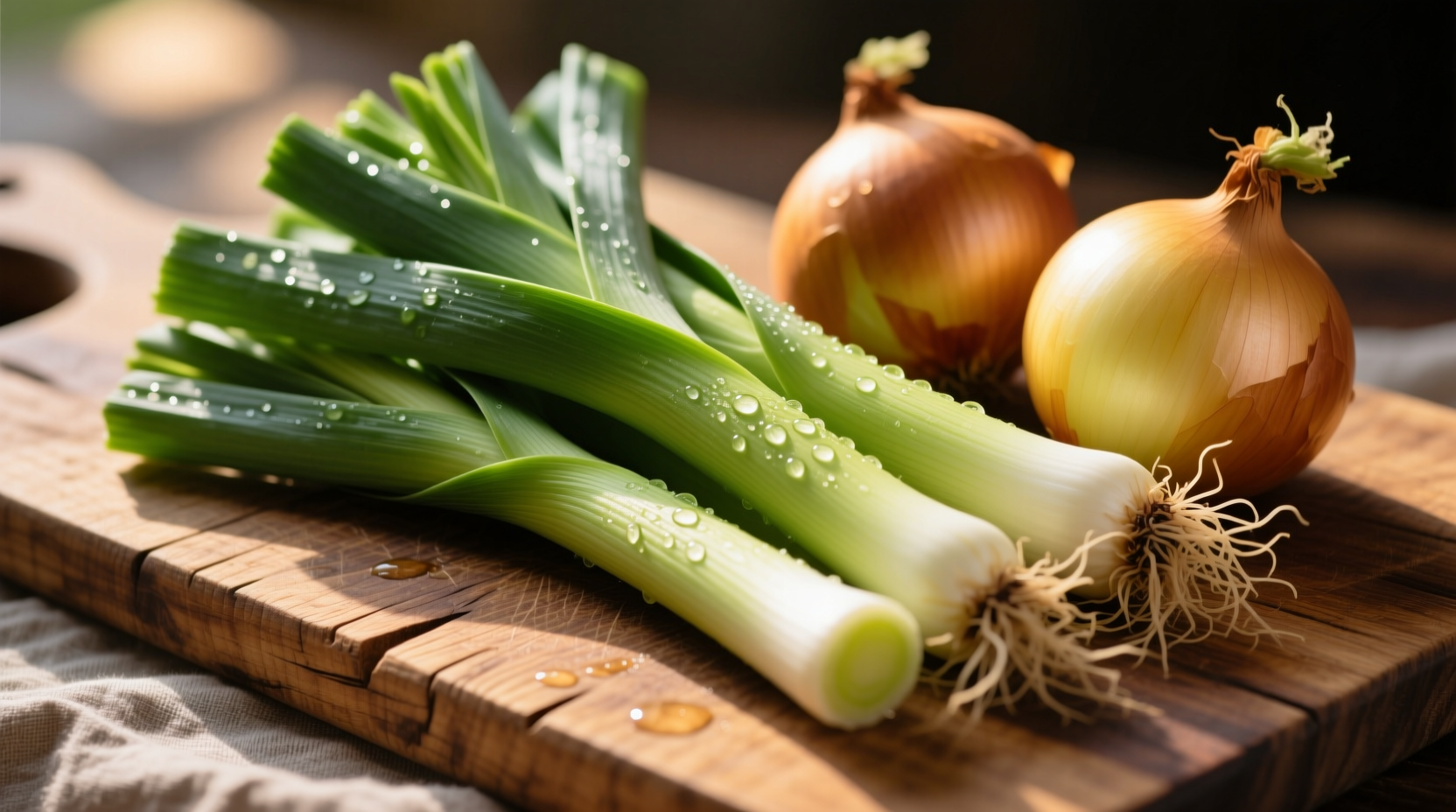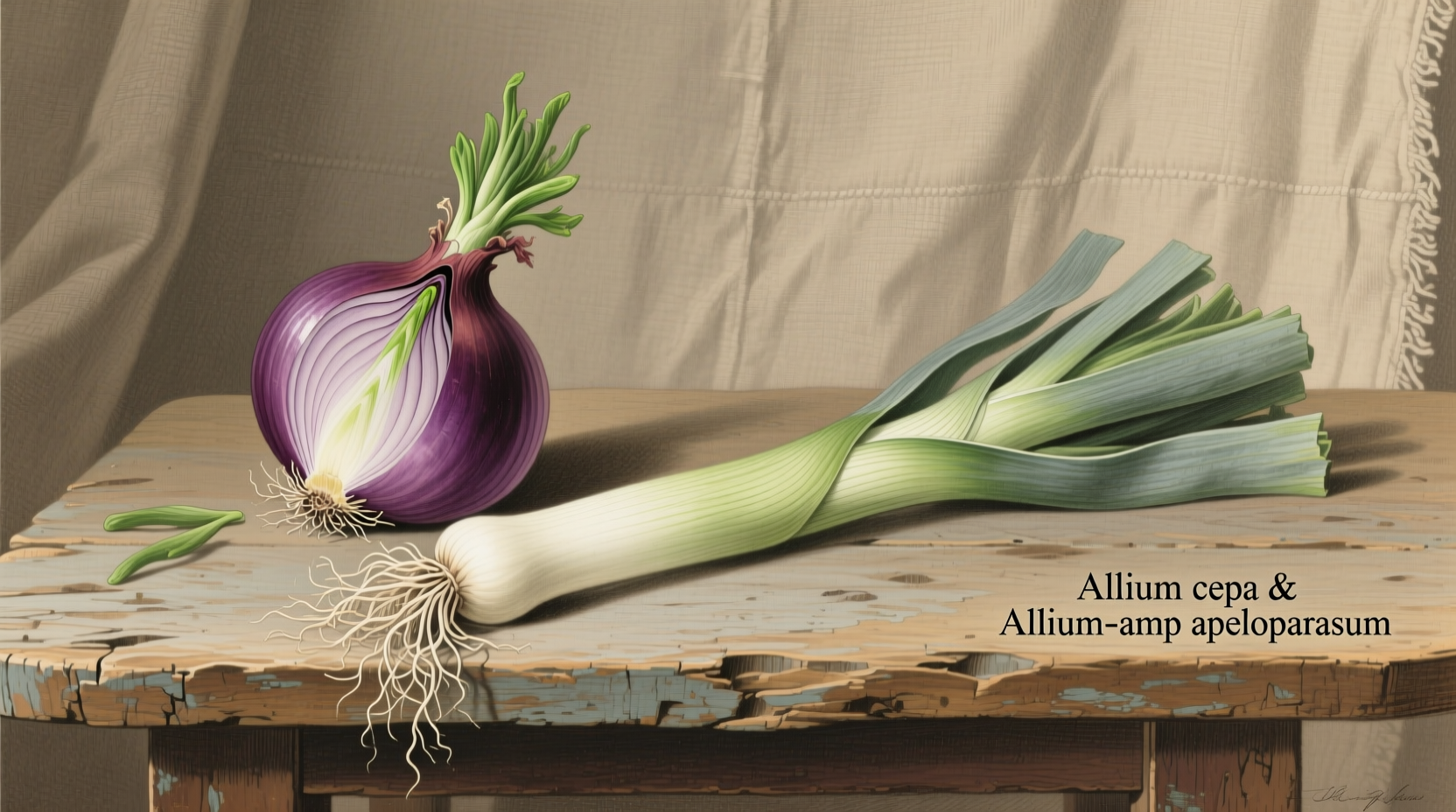Understanding Onion and Leek Fundamentals
While both members of the Allium family share visual similarities, their flavor profiles and culinary applications differ significantly. Onions contain higher levels of sulfur compounds, creating that characteristic sharp bite that transforms into sweetness when caramelized. Leeks, with their layered white and light green stalks, provide a more delicate, nuanced flavor that won't overpower delicate dishes.
| Characteristic | Onion | Leek |
|---|---|---|
| Flavor Intensity | Strong, pungent (raw), sweetens when cooked | Mild, sweet, subtle garlic notes |
| Best Culinary Uses | Sautéing base, grilling, roasting, raw applications | Creamy soups, delicate sauces, braises, garnishes |
| Storage Duration | 1-2 months in cool, dark place | 1-2 weeks refrigerated |
| Edible Parts | Entire bulb | White and light green sections only |
Selecting Quality Alliums: What to Look For
Choosing fresh, high-quality onions and leeks dramatically impacts your cooking results. For onions, select firm bulbs with dry, papery skins free from soft spots or mold. The heavier the onion feels for its size, the juicier it will be. Avoid any with green sprouts, which indicate age and diminished flavor.
When selecting leeks, look for crisp, firm stalks with vibrant green tops and bright white bases. The white portion should feel solid, not hollow or slimy. Larger leeks (over 1.5 inches in diameter) often have tougher outer layers but provide more usable white section. According to USDA agricultural guidelines, peak leek season runs from fall through early spring, when they develop their sweetest flavor profile.

Proper Preparation Techniques
Cleaning leeks properly is crucial—they often contain hidden dirt between their layers. Start by trimming the dark green tops (reserve for stock) and root end. Slice vertically through the white base, then separate the layers under cold running water, gently separating each layer to remove trapped soil. This method, recommended by culinary professionals at the Culinary Institute of America, ensures thorough cleaning without damaging the delicate structure.
For onions, reduce eye irritation by chilling them for 30 minutes before cutting, which slows the release of sulfur compounds. Use a sharp knife on a stable cutting surface, and cut from root to stem rather than the reverse to minimize vapor release. Professional chefs often leave the root intact until final cuts to maintain structural integrity during slicing.
Culinary Applications and Substitution Guidelines
Understanding when to use each allium transforms your cooking. Onions form the flavor foundation in most savory dishes—the "holy trinity" in Cajun cooking, mirepoix in French cuisine, and sofrito in Latin cooking all rely on onions for their characteristic depth. Their robust flavor withstands long cooking times, making them ideal for stews, braises, and grilled applications.
Leeks shine in dishes where subtlety matters. Their delicate flavor enhances without dominating, making them perfect for creamy soups, delicate sauces, and seafood dishes. When substituting leeks for onions, use twice the volume of leeks to achieve similar flavor impact, as their milder taste requires greater quantity. However, never substitute onions for leeks in traditional recipes like vichyssoise—this fundamentally alters the dish's character.
| Culinary Context | Recommended Allium | Why It Works |
|---|---|---|
| Base for tomato sauce | Yellow onion | Provides necessary acidity balance and depth |
| Creamy potato soup | Leek | Delicate flavor complements potatoes without overpowering |
| Raw application (salsa) | Red onion | Vibrant color and sharp bite cuts through rich ingredients |
| Quiche or tart | Leek (white portion) | Melts beautifully without releasing excess moisture |
Nutritional Comparison and Health Benefits
Both vegetables offer significant health benefits while differing nutritionally. According to USDA FoodData Central, one cup of cooked leeks (100g) contains 31 calories, 1.5g protein, and provides 24% of your daily vitamin K needs. Onions offer slightly fewer calories (26 per 100g cooked) but deliver higher levels of vitamin C and quercetin, a powerful antioxidant.
The sulfur compounds responsible for onions' pungency also provide anti-inflammatory benefits and may support cardiovascular health. Leeks contain kaempferol, a flavonoid associated with reduced risk of chronic diseases. Both vegetables contribute prebiotic fiber that supports gut health, though onions contain more fructooligosaccharides that feed beneficial gut bacteria.
Avoiding Common Preparation Mistakes
Even experienced cooks make critical errors with these alliums. The most frequent mistake with leeks is improper cleaning—failing to separate layers thoroughly leaves gritty residue in finished dishes. Another common error is using the entire leek; the dark green portions are too fibrous for most applications (though excellent for stock).
With onions, overcooking destroys their structural integrity, turning them to mush. For caramelization, maintain medium-low heat and patience—true caramelization takes 30-40 minutes. Rushing with high heat causes burning rather than proper browning. Additionally, many cooks discard onion skins, which contain valuable quercetin; simmer them in stocks for added nutritional benefit.
Storage Methods for Maximum Freshness
Proper storage extends usability significantly. Store whole onions in a cool, dark, well-ventilated space—never in plastic bags, which trap moisture and accelerate spoilage. Keep them away from potatoes, which release gases that cause onions to sprout prematurely. For cut onions, store in airtight containers in the refrigerator for up to 7 days.
Leeks require refrigeration even when whole. Wrap them loosely in a damp paper towel inside a perforated plastic bag. This maintains humidity without creating a soggy environment. Sliced leeks should be submerged in water in an airtight container, changing the water daily, which prevents oxidation and extends freshness up to 5 days.











 浙公网安备
33010002000092号
浙公网安备
33010002000092号 浙B2-20120091-4
浙B2-20120091-4